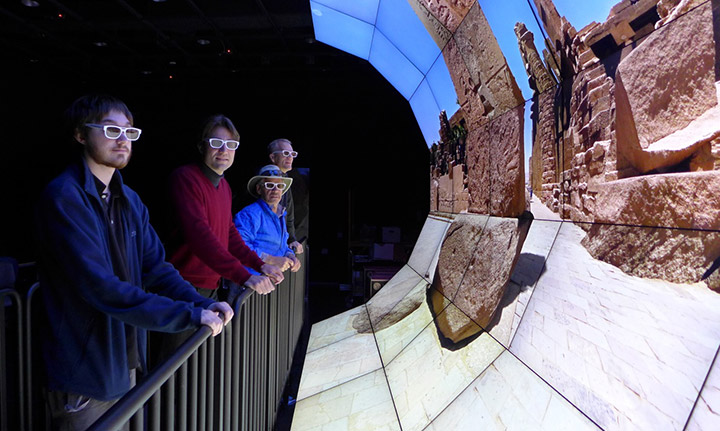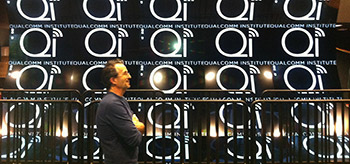New WAVE Display Technology Rises at UC San Diego
By:
- Tiffany Fox
Published Date
By:
- Tiffany Fox
Share This:
Article Content

Chris McFarland, Jurgen Schulze, Greg Dawe and Andrew Prudhomme check out a demo on the WAVE.
The next phase in the evolution of high-tech displays is here, and this time, the term ‘leading edge’ isn’t just a catchy slogan, but an evocative description of the technology’s look and feel.
The University of California, San Diego’s new WAVE display, true to its name, is shaped like an ocean wave, with a curved wall array of 35 55” LG commercial LCD monitors that end in a ‘crest’ above the viewer’s head and a ‘trough’ at his or her feet. An acronym for Wide-Angle Virtual Environment, it was designed and built in-house by QI’s Director of Visualization Tom DeFanti, QI Professor of Visualization and Virtual Reality Falko Kuester and Senior Design Engineer Greg Dawe. The WAVE, a 5x7 array of HDTVs, is now 20’ long by nearly 12’ high.
WAVE Display Specs
- Network: 40Gb (routes to prism core at Atkinson Hall and beyond) - Switch: Arista 7050QX
- Displays: LG 55WV70MD (35 - 5 Cols x 7 Rows)
- GPU: nVidia GTX 780ti (1 dedicated GTX 780ti per display)
- CPU: Xeon(R) CPU E5-2660
- RAM: 32G
- Disk: Samsung 512 GB SSD
- OS: Centos 6.4 x86_64
- Middleware: CalVR
Under the leadership of researchers at the UC San Diego division of the California Institute for Telecommunications and Information Technology (Calit2) – known as the Qualcomm Institute (QI) – high-resolution computerized displays have evolved over the past decade from 2D to 3D panels and from one monitor to arrays of many monitors. They’ve transitioned from stationary structures to structures on wheels, and from thick bezels (the rim that holds the glass display) to ultra-narrow bezels. Such technology is now widely used in television newsrooms, airports and even retail stores, but not in 3D like the WAVE.
The WAVE was funded, in part, by a $3.4 million grant from the National Science Foundation’s Major Research Instrumentation Program, with matching funds from UCSD, its Jacobs School of Engineering, the Department of Computer Science and Engineering, the Department of Structural Engineering and QI. The Intel University Program Office donated the system’s Xeon server-class multicore processors. “The WAVE was designed as part of the SCOPE project, or Scalable Omnipresent Environment, an effort to build a distributed big data visualization environment that serves as both a microscope and telescope and enables users to explore data from the nano to micro to macro to mega scale, allowing team members to explore a multitude of grand-challenges in the sciences and engineering,” said Prof. Kuester, the project’s principal investigator.
With the creation of the WAVE, “we wanted to give people an experience of looking over the edge, of hanging off a railing like you might do at the Grand Canyon,” says DeFanti, who is world-renowned for his work developing high-resolution immersive displays. “To do that, we had to provide an image above and below the viewer. When the data comes up and the ground plane disappears underneath you, you it really feels like you’re flying over the data.”

Joe Keefe of the Qualcomm Institute stands in front of the WAVE.
DeFanti said the WAVE was born from a desire to feel completely immersed in data, as if the viewer is actually part of the scene. And it’s not just ‘eye candy,’ either. The ability to see data at a resolution of tens of millions of pixels has important research implications for those working in, say, the biological sciences, archaeology or structural engineering. Earlier projector-based technologies, such as the QI StarCAVE, provide the feeling of being surrounded by an image and make it possible to ‘walk through’ a model of a protein or a building, for example, but the StarCAVE requires a huge room, and is not movable or replicable.
By contrast, the WAVE can be erected against a standing wall and can be moved and repliciated. WAVE content can be clearly viewed by 20 or more people at once, not possible in earlier immersive displays at UCSD. Its curved aluminum structure, designed by Dawe, is also a technical ‘fix’ for the problem of images on 3D passively polarized screens appearing as double images when placed in a large, flat array. With a curved array, the viewer can stand anywhere in front of the WAVE and experience excellent 3D with no visual distortion.
All the VR content and techniques developed over the years for engineering, medical, archaeology, tourism and other uses in the StarCAVE can be seen in the WAVE since it also uses QI's CalVR software libraries, designed and written by Research Scientist Jurgen Schulze and Programmer Analyst III Andrew Prudhomme.
“One of the reasons I found the curvature appealing is that it feels like the department store windows of yore, or museum dioramas, in which the glass is positioned away from you and you can’t touch it, so it doesn’t feel like it’s there,” adds DeFanti. “The WAVE achieves that illusion very nicely and in high resolution.”
The WAVE’s commercial LCD panels also render images more brightly, at a higher resolution and contrast and in much better alignment than the StarCAVE, making it appropriate for use in laboratories, museum spaces and galleries. Its debut, in fact, took place last summer at the opening of the Qualcomm Institute’s “EX3: Exodus, Cyber-Archaeology and the Future” exhibition, which was produced by UCSD Anthropology Professor and QI affiliate Tom Levy in partnership with DeFanti and Kuester. More than 500 viewers – including UCSD Chancellor Pradeep Khosla – were able to ‘fly through’ a 3D geographical model of three regions of the Sinai Peninsula where the Biblical Exodus possibly took place. QI’s Jessica Block and Philip Weber created the 3D flyover showing conceivable routes for the Exodus that have been proposed by scholars over the years.
The Exodus exhibition was a proof of concept for ‘the museum of the future,’” explains Prof. Kuester, who also serves as the director of the Center of Interdisciplinary Science for Art, Architecture and Archaeology, highlighting that a technologically empowered museum is desirable and achievable, providing unique new formats to explore and experience world cultural heritage. The QI visualization technical team that built the Exodus exhibit also included Eric Lo, Joe Keefe and Chris McFarland who built the WAVE computers and wired them to the screens.
The WAVE is part of the new UC San Diego Structural and Material Engineering building's Visualization Lab, also known as the WAVElab. The WAVE will be used for visualization research in a wide range of projects, from structural engineering to cultural heritage and archaeology. A portable 110” diagonal screen version, dubbed the “WAVElet,” has been built that can move around on wheels and be shipped anywhere in its integral road case. Already its designers are thinking of ways to tweak the technology – they hope to eventually build these panels it into not just a wave, but perhaps a completely immersive tube akin to the ideal wave of surfers’ dreams.
“This is La Jolla, after all,” jokes DeFanti.
Share This:
Stay in the Know
Keep up with all the latest from UC San Diego. Subscribe to the newsletter today.



